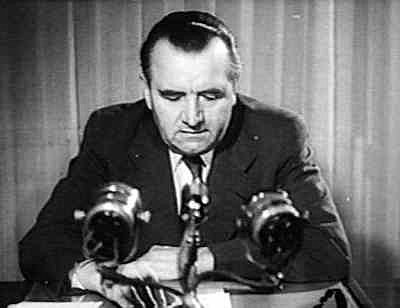→ The people’s democracies around the USSR

—the USSR sets up communist regimes in the Central European states (Romania in 1945, Bulgaria, Hungary and Poland in 1947, Czechoslovakia in 1948 and the GDR in 1949)
—Prague coup on February 25, 1948, by the Czech communists, with the support of the USSR (under pressure from the communists led by Gottwald, President Benes had to resign)
—purges organized by Joseph Stalin (Rostov in Bulgaria arrested and killed, Gomulka in Poland imprisoned, Rajk in Hungary executed)
→ The formation of a Soviet bloc
—implementation of the Soviet doctrine in all the countries of Central Europe
—signing of the Warsaw Pact in 1955 at the initiative of Nikita Khrushchev in opposition to NATO
—cOMECON (or CMEA, Council for Mutual Economic Assistance) in January 1949, bringing together the USSR, Bulgaria, Czechoslovakia, Hungary, Poland and Romania
→ The cracks in the Soviet bloc
—Tito at the head of Yugoslavia expresses his opposition to Joseph Stalin
—Khrushchev states Joseph Stalin’s crimes on the occasion of the XX Congress of the Communist Party (CPSU) in 1956, giving rise to demands for autonomy in Poland and Hungary (with Imre Nagy, Budapest revolt)
—Prague Spring in 1968: in reaction to the will of relative liberalization on the part of the Czechoslovak Communist Party, advocating a “socialism with a human face” with Alexander Dubček, the troops of the Warsaw Pact invaded the capital.
→ The end of the people’s democracies
—Ostpolitik of Willy Brandt (policy of opening up to the East)
—Leaders impose themselves against communism in Hungary, Poland (Lech Walesa), Czechoslovakia
—After the break-up of the USSR in 1991, Czechoslovakia was separated into the Czech Republic and Slovakia in 1992.
—Yugoslavia, a mosaic of nationalities, succumbed to the war, which left at least 200,000 dead. Slovenia and Croatia claim their independence in 1991; in turn Bosnia-Herzegovina in March 1992 triggers a war of independence (UN intervention, siege of Sarajevo).
—War in Kosovo, Federal Republic of Yugoslavia admitted to the UN in 2000, independence of Montenegro which separates from Serbia.
→ 20 contemporary history cards (1945–2017)

Liberal democracy versus popular democracy AND THE DICTATORIES OF THE SOUTH. The parties do not seem very balanced (46 years against 19 years). However, what is said is correct and the addition of the Fukuyama analysis is excellent
Hi everybody ! I have a question, in history I made an outline in 2 parts, 1-Democracy in full difficulty 1945-91: Liberal democracy has difficulty in imposing itself in the face of the rigor of the ussr and the satellite countries (popular democracy) Tensions even in liberal democracies: May 68 Then little by little, confidence in democracy in Spain in 81 (after the coup) 2- the success/triumph of democracy 1991 to the present day – end of the story: fukuyama -fall of the ussr -the eastern countries choose the market eco and liberal demo: the proof: integration into the eu -however some problems remain: abstention, a postponed democracy in question: the outraged, demonstration in Hungary, rise of the far right (golden dawn and fn) and protest in russia which is still part of europe (pussy riot, violation of freedom of expression) do you think?